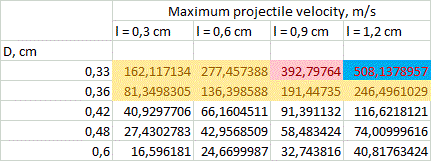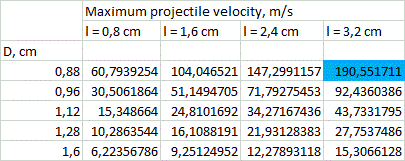
Maximum speed in SCR-driven multistage reluctance accelerator
_Eugen_, Wed May 08 2019, 12:33PMLimitations for the speed achievable in a reluctance coilgun commutated by thyristors is investigated based on geometrical properties of the accelerating coils. Thermal, and also capacitor weight and ESR issues are taken into account.
Details are on this page.
Below are brief resuls and discussion.
Re: Maximum speed in SCR-driven multistage reluctance accelerator
_Eugen_, Wed May 08 2019, 12:36PM

_Eugen_, Wed May 08 2019, 12:36PM

Re: Maximum speed in SCR-driven multistage reluctance accelerator
_Eugen_, Wed May 08 2019, 12:42PM
Tables of solution for vmax for different calibers d are resolved below. The range of lengths of a coil, like in my previous paper, is in the limits from l = d to l = 4·d (longer coils are ineffective according to FEMM modelling and lot of experimental data), and outer diameters are from D = 1,1·d to D = 2·d.

d=3 mm

d= 5 mm

d=8 mm

d=12 mm

d=20 mm
_Eugen_, Wed May 08 2019, 12:42PM
Tables of solution for vmax for different calibers d are resolved below. The range of lengths of a coil, like in my previous paper, is in the limits from l = d to l = 4·d (longer coils are ineffective according to FEMM modelling and lot of experimental data), and outer diameters are from D = 1,1·d to D = 2·d.

d=3 mm

d= 5 mm

d=8 mm

d=12 mm

d=20 mm
Re: Maximum speed in SCR-driven multistage reluctance accelerator
_Eugen_, Wed May 08 2019, 12:47PM
Coloration of some cells means:
Red - overheat (temperature of wire more than 300 C - this is a point when heat-resistant electrical varnish loses its isolating abilities)
Blue - this corresponds to total accumulated energy more 2 kJ and capacitor mass of more than 6 kg - clearly close to a limiting value for a portable system
Yellow - unachievable because of the capacitor ESR issues.
_Eugen_, Wed May 08 2019, 12:47PM
Coloration of some cells means:
Red - overheat (temperature of wire more than 300 C - this is a point when heat-resistant electrical varnish loses its isolating abilities)
Blue - this corresponds to total accumulated energy more 2 kJ and capacitor mass of more than 6 kg - clearly close to a limiting value for a portable system
Yellow - unachievable because of the capacitor ESR issues.
Re: Maximum speed in SCR-driven multistage reluctance accelerator
_Eugen_, Wed May 08 2019, 12:48PM
Results and discussion.
Following conclusions can be made from the results obtained above.
1) On the assumption of the geometrical properties of multistage SCR-driven accelerators, theoretical velocities up to 200 m/s are achievable for the calibers of less than 8 mm. The highest-speed caliber is about 5 mm.
2) The obstacles on the way to higher speeds are overheat of the coils and (mainly) ESR of the capacitors for small-bore coilguns, and huge mass of the power capacitor for large-bore ones. For 20 mm and larger calibers velocities of more than 80 m/s cannot be obtained exclusively because of geometry of the coils (even without the "weight" limitation).
It is clear that small calibers are the most attractive for breakthrough to high velocities. Such a conclusion is not very encouraging from the constructor's point of view, because the less is the caliber - the more stages (and thyristors, and sensors and so on) we should mount to preseve the same acceleration path. A way how to avoid ESR-limit is also unclear - perhaps, it will be overcome when new technologies of the electrolytics, or new types of capacitors themselves appear.
Nevertheless, it can be concluded that a potential of SCR-driven portable multistage electromagnetic accelerators is not yet exhausted, and one may expect for new and new constructions to be projected and demonstrated soon...
_Eugen_, Wed May 08 2019, 12:48PM
Results and discussion.
Following conclusions can be made from the results obtained above.
1) On the assumption of the geometrical properties of multistage SCR-driven accelerators, theoretical velocities up to 200 m/s are achievable for the calibers of less than 8 mm. The highest-speed caliber is about 5 mm.
2) The obstacles on the way to higher speeds are overheat of the coils and (mainly) ESR of the capacitors for small-bore coilguns, and huge mass of the power capacitor for large-bore ones. For 20 mm and larger calibers velocities of more than 80 m/s cannot be obtained exclusively because of geometry of the coils (even without the "weight" limitation).
It is clear that small calibers are the most attractive for breakthrough to high velocities. Such a conclusion is not very encouraging from the constructor's point of view, because the less is the caliber - the more stages (and thyristors, and sensors and so on) we should mount to preseve the same acceleration path. A way how to avoid ESR-limit is also unclear - perhaps, it will be overcome when new technologies of the electrolytics, or new types of capacitors themselves appear.
Nevertheless, it can be concluded that a potential of SCR-driven portable multistage electromagnetic accelerators is not yet exhausted, and one may expect for new and new constructions to be projected and demonstrated soon...
Print this page